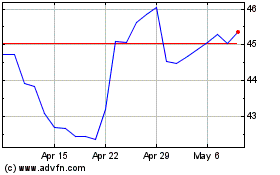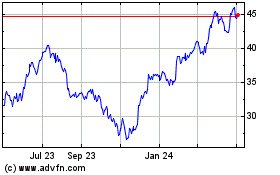By Mike Colias and Nora Naughton
The United Auto Workers strike at General Motors Co. is heading
into its second week as union and company bargainers face
unresolved issues ranging from the use of temporary workers to
wages for newer hires, according to people close to the talks.
The strike is already the UAW's longest nationwide walkout at GM
since 1970. It has sent tens of thousands of auto workers to picket
lines, and halted work at more than 30 U.S. plants. On Sunday, the
union hosted rallies across the country, attended by Democratic
presidential candidates Elizabeth Warren in Michigan and Joe Biden
in Kansas.
While the two sides made some progress negotiating through the
weekend, they remain at odds on several key issues and plan to
return to the bargaining table Monday morning, the people said.
GM, for instance, has been pushing to expand the use of
temporary workers to give it more flexibility when sales slow or
market conditions change, while union negotiators want to limit the
practice. The UAW argues that these workers earn less in wages for
performing the same jobs as full-time employees and should have a
more guaranteed path to permanent employment.
The union is pressing to shorten the eight-year phase-in period
for new hires to reach the top wage, a provision put in place
during the 2015 negotiations, the people close to the talks said.
The sides are still negotiating over the length of that period,
they said.
Profit-sharing remains on the table, as well. GM has proposed
enhancing the formula, which currently pays workers $1,000 for
every $1 billion in North American pretax profit that the company
earns each year, the people close to the talks said.
In recent years, GM has paid out annual profit-sharing bonuses
of more than $10,000 per worker. The union is pushing to extend
profit-sharing payouts to temporary workers, which the company is
resisting, these people said.
The sides are also discussing ways to blunt the impact of GM's
decision last year to close several U.S. plants, including the
possibility of a new battery plant in the same northwest Ohio area
where GM closed a large assembly plant, these people said.
GM entered talks with the goal of holding the line on labor
costs, wary of a potential slowdown in the U.S. car market after
nearly a decade of strength. The company angered the union months
before talks began with its decision in November to shutter four
U.S. factories, part of a broader plan to lower fixed costs while
steering more investment toward future bets on driverless and
electric vehicles.
Job security and the fate of those plants, including GM's
assembly plant in Lordstown, Ohio, have loomed large in
negotiations. The Lordstown factory was closed last spring after
demand for its lone model, the Chevy Cruze, faded. GM negotiators
have maintained during bargaining sessions that it doesn't have
fresh models to earmark for Lordstown, people close to the talks
said.
As a compromise, GM has proposed establishing an electric-car
battery factory nearby that would employ several hundred workers,
helping to offset job reductions related to the plant closure in
Lordstown, these people said. Roughly 1,400 people were working at
that factory before it closed.
The union has said GM's last proposal before the contract
deadline, submitted just after 10 p.m. Sept 14, came too late to
avoid a strike. That proposal included the battery plant. Talks on
details of the plan are continuing, the people close to the talks
said.
Separately, GM is trying to facilitate the sale of the factory
to a newly formed startup that wants to build electric trucks
there.
GM would partner with at least one outside company to establish
the battery plant and would ensure that the facility would be
staffed by UAW-represented workers, though wages would likely be
lower than the nearly $30 an hour that most Lordstown workers had
been paid, the people said.
For example, UAW workers at a GM plant in suburban Detroit where
battery packs are assembled for use in electric vehicles are paid
$15 to $17 per hour. Wages at the proposed battery cell plant
likely would be in that range, the people said.
The location of the plant and whether GM would own and operate
it couldn't be learned.
GM has framed the battery-plant idea as a way of opening a path
for the UAW to gain jobs in areas with the potential to grow as
auto makers invest more in electric vehicles. Workers at a large
battery plant in Michigan operated by LG Chem aren't represented by
the UAW.
"There are all kinds of new technologies coming, and it becomes
a Catch-22 for the union if they want to be part of it," said
Kristin Dziczek, a labor expert at the Center for Automotive
Research in Ann Arbor, Mich. She said the union is likely being
careful not to set lower standards for these jobs.
While battery-powered cars are still only a fraction of the U.S.
car market, the UAW is facing the potential of lost factory jobs at
plants that make engines and transmissions as GM and other car
companies invest more in electric vehicles.
"It's about getting a toehold before these new technologies
become dominant," Ms. Dziczek said.
The UAW is trying to fend off declining membership and is in the
throes of a federal corruption investigation that has led to nine
convictions.
Anger at GM among rank-and-file UAW members and their discontent
with union leadership over the criminal probe could make it more
difficult to pass a deal. A tentative agreement between GM and the
UAW needs a majority vote to ratify. Fiat Chrysler workers in 2015
voted down the first tentative agreement before passing a second,
richer agreement.
Write to Mike Colias at Mike.Colias@wsj.com and Nora Naughton at
Nora.Naughton@wsj.com
(END) Dow Jones Newswires
September 22, 2019 21:28 ET (01:28 GMT)
Copyright (c) 2019 Dow Jones & Company, Inc.
General Motors (NYSE:GM)
Historical Stock Chart
From Aug 2024 to Sep 2024

General Motors (NYSE:GM)
Historical Stock Chart
From Sep 2023 to Sep 2024
